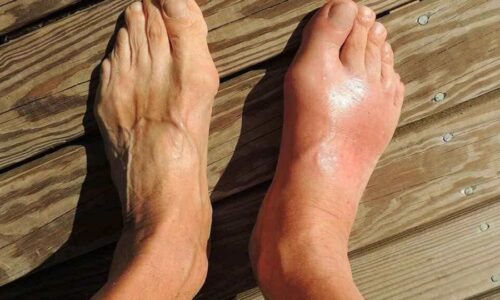
What is Gout in the Knee
Gout is a form of arthritis that can affect various joints in the body, including the knee. It is characterized by sudden and severe pain, swelling, redness, and tenderness in the affected area. Gout typically occurs when there is an excessive buildup of uric acid in the bloodstream, leading to the formation of urate crystals in the joints.
Understanding Gout in the Knee
When gout affects the knee, it can cause intense pain and discomfort. The knee joint becomes inflamed as urate crystals accumulate in the synovial fluid. This buildup triggers an inflammatory response from the body, resulting in the characteristic symptoms of gout.
Causes of Gout in the Knee
Gout in the knee is primarily caused by a condition known as hyperuricemia, where there is an elevated level of uric acid in the bloodstream. This excess uric acid can lead to the formation of urate crystals, which can accumulate in the joints, including the knee. When these crystals build up in the knee joint, they trigger an inflammatory response from the body, resulting in the characteristic symptoms of gout.
Several factors contribute to the development of hyperuricemia and subsequent gout in the knee:
- Diet: Consuming foods high in purines, such as red meat, organ meats, seafood, and certain vegetables, can increase uric acid production. When the body breaks down purines, uric acid is produced as a waste product.
- Genetics: Some individuals have a genetic predisposition to gout. If gout runs in your family, you may be more susceptible to developing the condition.
- Obesity: Excess weight can lead to an increased production of uric acid and a reduced ability of the kidneys to eliminate it. This combination raises the risk of hyperuricemia and gout.
- Alcohol Consumption: Alcohol, particularly beer, can interfere with the body’s ability to eliminate uric acid, leading to its accumulation.
Symptoms and Diagnosis
Gout in the knee is characterized by a distinct set of symptoms that can be both sudden and severe. Recognizing these symptoms is crucial for timely diagnosis and effective management. Here are the common symptoms of gout in the knee:
- Intense Pain: Gout often manifests as sudden and excruciating pain in the affected knee. The pain is usually at its worst within the first 4-12 hours of onset.
- Swelling: The knee joint becomes swollen, tender, and visibly larger due to the accumulation of urate crystals and the resulting inflammation.
- Redness: The affected knee may appear red and warm to the touch, indicating the inflammatory response triggered by the urate crystals.
- Limited Mobility: The pain and swelling can restrict movement, making it difficult to bend or straighten the knee without discomfort.
- Night Attacks: Gout attacks frequently occur during the night, waking individuals from sleep with intense pain.
Treatment Options
Effectively managing gout in the knee involves a combination of addressing acute flare-ups, preventing future attacks, and making lifestyle adjustments to reduce the frequency and severity of gout episodes. Here are the primary treatment options available for individuals dealing with gout in the knee:
Medications:
- Nonsteroidal Anti-Inflammatory Drugs (NSAIDs): NSAIDs like ibuprofen and naproxen can provide relief from pain and reduce inflammation during gout flares.
- Colchicine: This medication helps reduce inflammation and pain associated with acute gout attacks. It is particularly effective if taken within the first 24 hours of symptom onset.
- Corticosteroids: Injected directly into the knee joint, corticosteroids swiftly alleviate inflammation and pain. Oral corticosteroids may also be prescribed for those who cannot tolerate injections.
Lifestyle Changes:
- Diet Modification: Adopting a low-purine diet can help reduce uric acid levels. Avoiding high-purine foods like organ meats, red meat, and seafood is recommended.
- Hydration: Staying well-hydrated aids in flushing out excess uric acid from the body, reducing the risk of crystallization in the joints.
- Weight Management: Maintaining a healthy weight can lower uric acid levels and decrease the frequency of gout attacks.
- Limit Alcohol: Reducing alcohol consumption, especially beer, can help prevent gout flares.
Long-Term Management:
- Urate-Lowering Therapy (ULT): For individuals with frequent gout attacks or chronic gout, ULT medications are prescribed to lower uric acid levels. Allopurinol and febuxostat are common ULT options.
- Prophylactic Medication: During the initial stages of ULT, a prophylactic medication like colchicine may be prescribed to prevent gout flares that can occur when uric acid levels decrease.
- Physical Therapy: Engaging in appropriate exercises and physical therapy can help maintain joint flexibility and strengthen the muscles surrounding the knee, reducing the risk of future gout attacks.
Preventing Gout in the Knee
Gout is a form of arthritis caused by excess uric acid in the blood, leading to the formation of crystals in the joints, commonly in the big toe, but it can affect other joints like the knee as well. Here are some steps to help prevent gout attacks in the knee:
- Medication: Consult with a healthcare provider to discuss medications that can help lower uric acid levels in the blood. These may include medications like allopurinol or febuxostat.
- Dietary Changes: Eat less purine-rich meals, such as shellfish, organ meats, and red meat, as they can raise blood levels of uric acid. Prioritize eating a well-balanced diet full of nutritious grains, fruits, vegetables, and dairy products with minimal fat.
- Hydration: Drink plenty of water throughout the day to help flush out excess uric acid from the body.
- Alcohol and Sugary Beverages: Limit consumption of alcohol and sugary beverages, as they can increase uric acid levels.
- Maintain a Healthy Weight: The risk of gout may rise with obesity. A balanced diet and frequent exercise should be combined to help you maintain a healthy weight.
Gout vs. Other Knee Conditions
Gout in the knee shares some similarities with other knee conditions like osteoarthritis and rheumatoid arthritis. However, gout is distinct in its rapid onset of intense pain, often occurring at night. For a precise diagnosis and the best course of therapy, these disorders must be distinguished from one another.
Conclusion
Gout in the knee can be a debilitating condition, causing intense pain and discomfort. By understanding its causes, symptoms, and treatment options, individuals can take proactive steps to manage gout and prevent flare-ups. A combination of medication, lifestyle changes, and dietary adjustments can lead to a better quality of life for those affected by gout.




